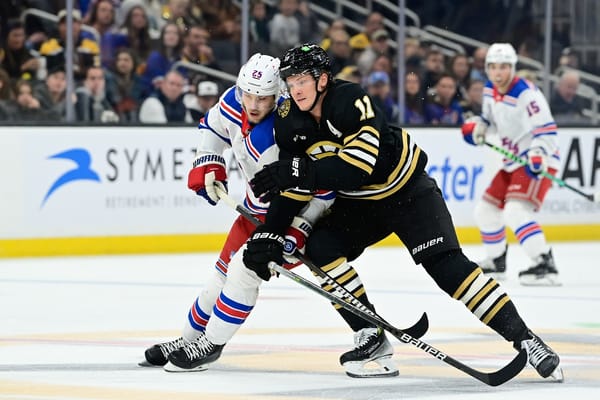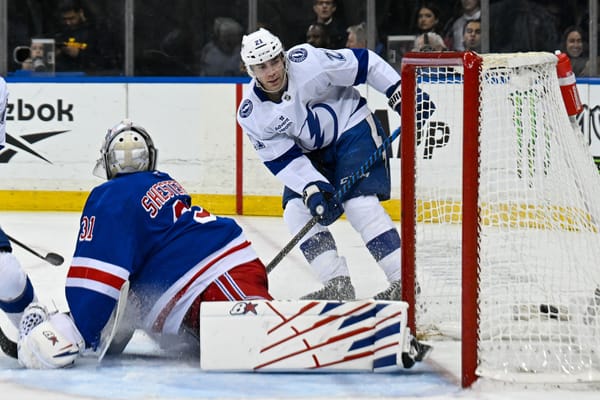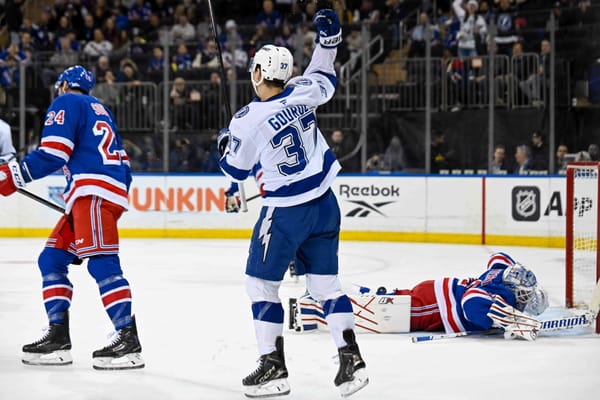Rykov and Hajek and the Training Camp Battle to Come
Now that Kevin Shattenkirk is out of the picture, we are starting to get a better idea of what the New York Rangers blue line is going to look like for the 2019-20 season. The biggest subtractions — Shattenkirk and Neal Pionk — and additions — Jacob Trouba and Adam Fox — are both obvious, but the changes go deeper than that.
Also out of the picture for next season are Fredrik Claesson and AHLers John Gilmour, Chris Bigras, Rob O’Gara, and Julius Bergman.
Gilmour and Bigras left the team as unrestricted free agents (the Rangers did not tender Bigras a qualifying offer) and Claesson and O’Gara remain unsigned UFAs. Bergman, who was acquired in the trade that sent Adam McQuaid to the Columbus Blue Jackets, was qualified this summer despite his known intensions to return to the SHL with Frölunda HC even before the deal was consummated.
There’s also a very strong chance Brendan Smith starts the season buried in the AHL for salary cap reasons. The Shattenkirk buyout gave the Rangers some breathing room in their cap crunch, but the team is still sucking in air through a straw right now. Burying Smith opens up another $1.075 million in space and also paves the way for a young defenseman to develop and test himself on the team’s third pair.
Naturally, Trouba will eat up the lion’s share of the ice time that Pionk and Shattenkirk saw last season. Remember, Pionk averaged 21:10 TOI/GP and Shattenkirk 18:56 TOI/GP last year and both played 73 games last season — that’s a lot of hockey. At this point with no NHL games on his resume, Fox shouldn’t be expected to play a role on par with Trouba, the $8 million a year man.
The big question mark facing the Rangers’ defense now is who will slot into the second or third pair on the left side.
The two leading candidates for the role are youngsters Libor Hajek and Yegor Rykov. And, although Hajek has already tasted what the NHL game is like, there’s a strong case to be made that Rykov is likely the better option unless something drastic happens in training camp.
Blueshirt Banter’s own Adam Herman ranked Rykov as the 9th-best Rangers prospect, while Hajek checked in at No. 14. A major factor in the perceived gap between the two defenders is Hajek’s play in the AHL. Infamously, Hajek notched just three points — two of which were primary — in 58 AHL games last season. As Adam mentioned in his ranking of Hajek, that lack of production in the league below the NHL was alarming even for a shutdown defender. There were also signs that he was out of his depth in his own zone.
From Adam’s prospect ranking of Hajek:
He was better defensively than he was offensively, but even that part of his game was inconsistent. He had some moments where his shutdown abilities really showed, and others where he looked out of place in the AHL.
Hajek’s most frequent partners in the AHL — measuring by AHLTracker.com’s goal event tracker — were Bigras and Brandon Crawley. Bigras led all Wolf Pack defenders with a 14.9 percent relative even strength goal differential (Rel ESGF%); Crawley ranked sixth on the team (among defensemen with at least 20 GP) with a minus-7.5 Rel ESGF%. Hajek, on the other hand, was last on the team with a minus-13.0 Rel ESGF%. That 58-game sample size is significantly larger than the five games in the NHL where he finished in the green in his on-ice shot share and had a Rel xGF% of 18.34.
Rykov, on the other hand, was one of the KHL’s HC Sochi’s best defenders last season. He took one more penalty than he drew and finished the season with a minus-4 rating on a team that finished minus-10 in goal differential (all strengths). Rykov, who is not lauded for his puck skills, notched nine points in 47 regular season games and picked up three assists in six playoff games playing in the second best hockey league in the world.
In addition to being 14 months older than Hajek, Rykov also has significantly more experience. While it’s true that Hajek dressed in five games for the Rangers last season, he has just 66 games of AHL experience under his belt. Rykov, on the other hand, has played in 193 KHL regular season and playoff games to go along with more than double the U20 World Championship games than Hajek.
With all of that being said, Rykov still needs to adjust to the North American ice surface and play style, not to mention a different culture in the United States. He’s very strong on the puck and has an efficient stride, which bodes well for him adapting to a smaller ice surface. One hurdle he may have to overcome is becoming more comfortable taking the body. According to the KHL’s official site, he is credited with just four hits in 157 career regular season games. Although, it’s important to note that tracking real-time stats like hits is far from a precise science.
The fact that Rykov will need to make those adjustments to his game makes the pending training camp battle between him and Hajek a must-watch story. Of course, Ryan Lindgren and Tarmo Reunanen will also be battling for that role, as will Smith if the team has the room to keep him. Lindgren’s game isn’t nearly as balanced as his peers, but he could win over the coaching staff with his physicality. Remember, the Rangers thought it was necessary to acquire McQuaid and add him to an already crowded blue line last year because they believed he brought something to the table that the team needed.
The amount of wrinkles in this training camp storyline would put a pug’s forehead to shame. There’s a very real chance that next year’s blue line will feature two rookies. The big question is, which two rookies will it be?
Data courtesy of khl.ru, CapFriendly.com, AHLTracker.com, and naturalstattrick.com.




